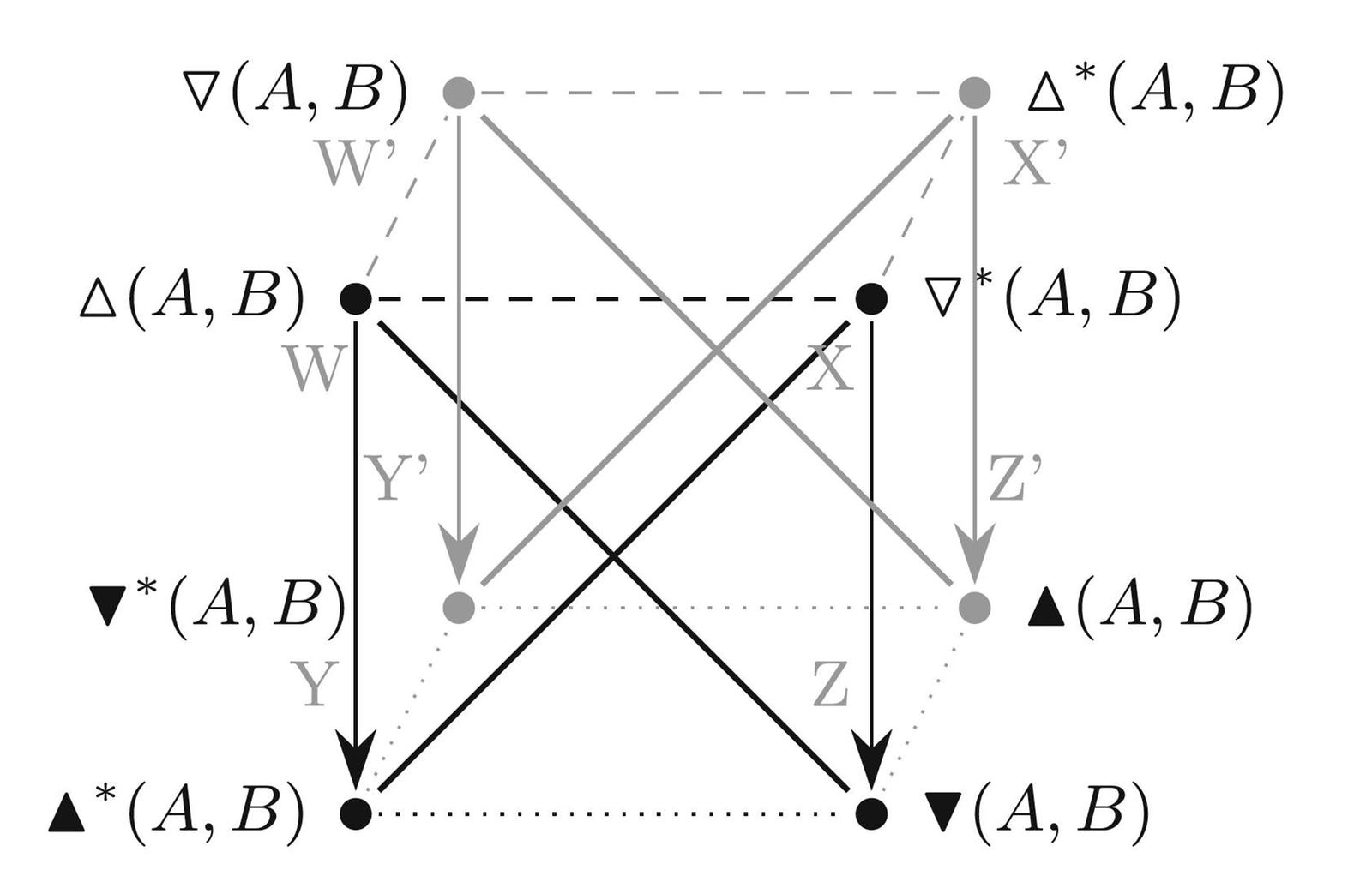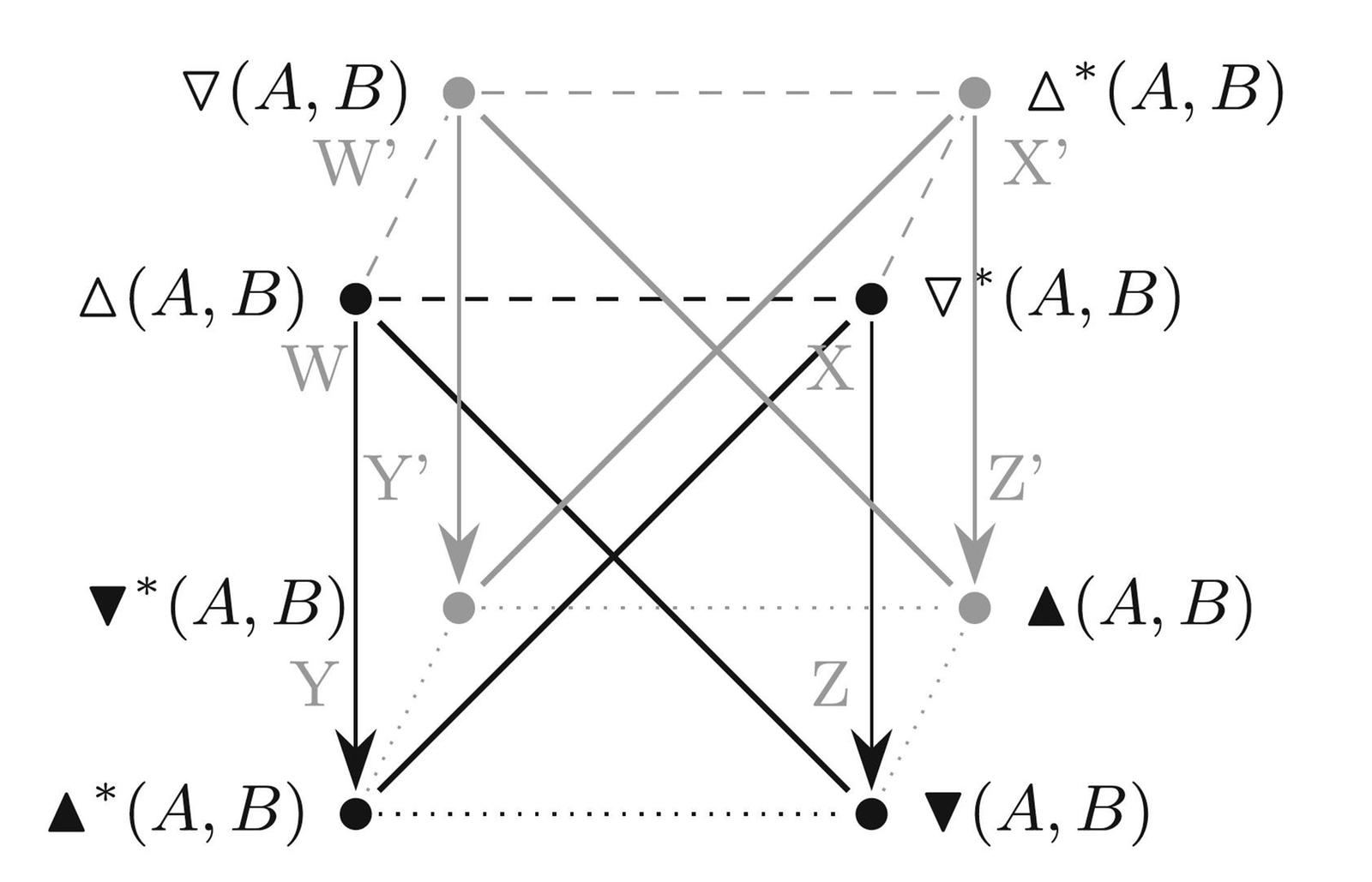
Normatively Determined Propositions (2022), p. 84
by Pascucci, Matteo; Pizzi, Claudio

Copyright according to our policy
Caption
- Aristotelian KD-cube for the eight dyadic operators
- Aristotelian family
- Lenzen Sigma-4
- Boolean complexity
- 5
- Number of labels per vertex (at most)
- 2
- Equivalence between (some) labels of the same vertex
- No
- Analogy between (some) labels of the same vertex
- No
- Uniqueness of the vertices up to logical equivalence
- Yes
- Errors in the diagram
- No
- Shape
- Cube (regular)
- Colinearity range
- 0
- Coplanarity range
- 0
- Cospatiality range
- 0
- Representation of contradiction
- By some other geometric feature
Logic
Geometry
- Conceptual info
- No
- Mnemonic support (AEIO, purpurea ...)
- No
- Form
- dots
- Label type
- symbolic ,
- generic placeholders
- Symbolic field
- logic
- Contains partial formulas or symbols
- No
- Logical system
- deontic logic
- Contains definitions of relations
- No
- Form
- dotted lines ,
- solid lines ,
- none ,
- dashed lines
- Has arrowheads
- Yes
- Overlap
- No
- Curved
- No
- Hooked
- No
- As wide as vertices
- No
- Contains text
- No
- Label type
- none
Vertex description
Edge description
- Diagram is colored
- No
- Diagram is embellished
- No
Style
Additional notes
- The two sequences of subalternations in this Lenzen sigma-4 look as follows:
$\triangle^*(A,B) \to \triangle(A,B) \to \blacktriangle(A,B) \to \blacktriangle^*(A,B)$
$\triangledown^*(A,B) \to \triangledown(A,B) \to \blacktriangledown(A,B) \to \blacktriangledown^*(A,B)$
P. 81:
$\triangle(A,B) := \Diamond A \wedge (\Box(A \to B) \vee \Box(A \to \neg B))$, meaning that $A$ is permitted and $B$ is normatively determined by $A$
$\triangle^*(A,B) := \Box A \wedge (\Box(A \to B) \vee \Box(A \to \neg B))$, meaning that $A$ is obligatory and $B$ is normatively determined by $A$
$\blacktriangle(A,B) := \Diamond A \to (\Box(A \to B) \vee \Box(A \to \neg B))$, meaning that if $A$ is permitted, then $B$ is normatively determined by $A$
$\blacktriangle^*(A,B) := \Box A \to (\Box(A \to B) \vee \Box(A \to \neg B))$, meaning that if $A$ is obligatory, then $B$ is normatively determined by $A$
$\triangledown(A,B) := \Diamond A \wedge (\Diamond(A \wedge B) \wedge \Diamond(A \wedge \neg B))$, meaning that $A$ is permitted and $B$ is not normatively determined by $A$
$\triangledown^*(A,B) := \Box A \wedge (\Diamond(A \wedge B) \wedge \Diamond(A \wedge \neg B))$, meaning that $A$ is obligatory and $B$ is not normatively determined by $A$
$\blacktriangledown(A,B) := \Diamond A \to (\Diamond(A \wedge B) \wedge \Diamond(A \wedge \neg B))$, meaning that if $A$ is permitted, then $B$ is not normatively determined by $A$
$\blacktriangledown^*(A,B) := \Box A \to (\Diamond(A \wedge B) \wedge \Diamond(A \wedge \neg B))$, meaning that if $A$ is obligatory, then $B$ is not normatively determined by $A$